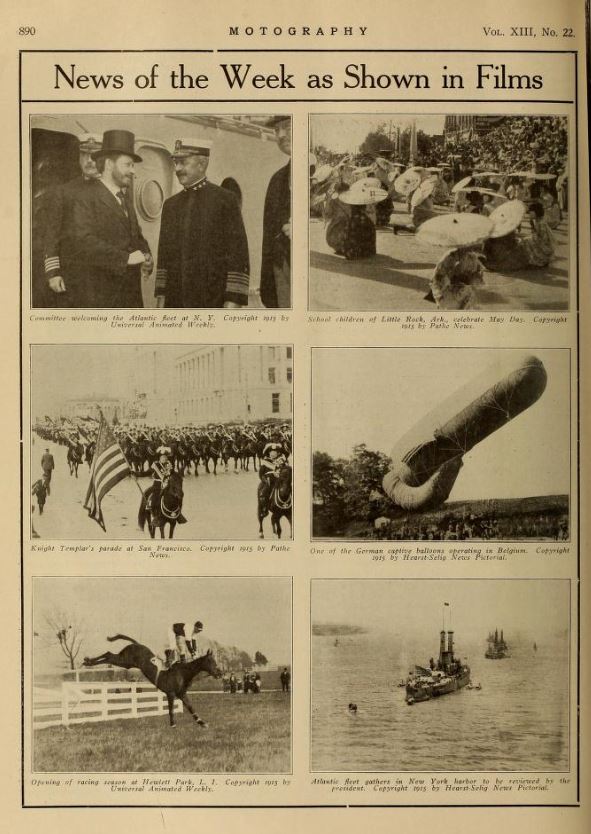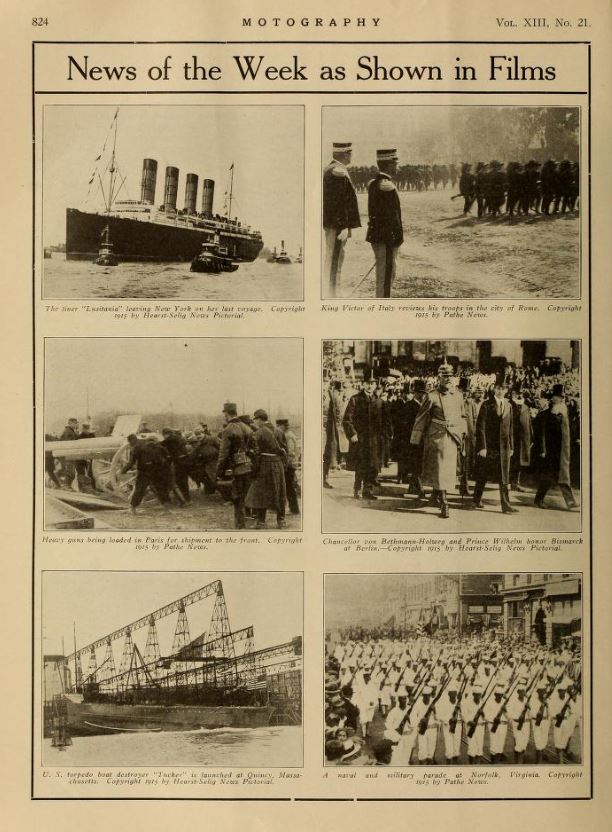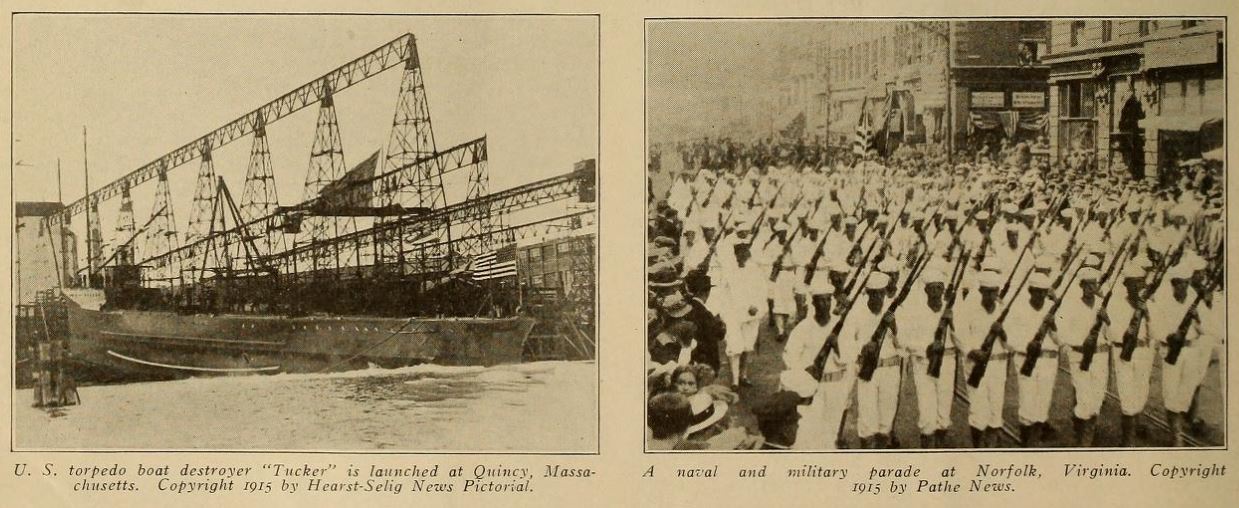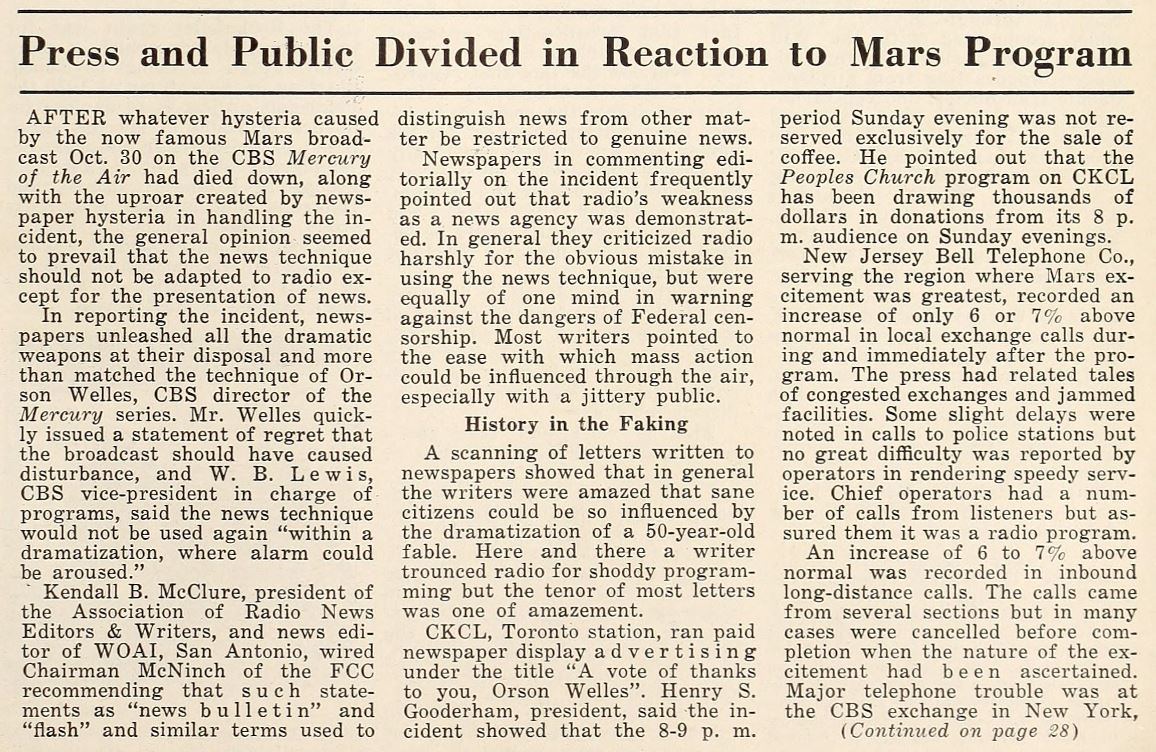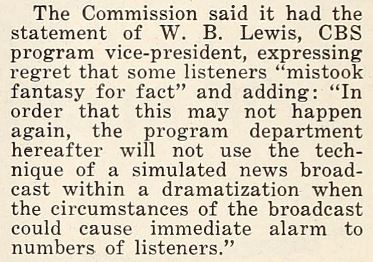 |
| Ogden Standard, 07-May-1915 |
After a year of war, Germany was not in a good position. The British had established a fairly tight blockade of imports, and the army had failed to take Paris and had settled into static positions on the Western Front. In order to disrupt vital shipping to Britain, Germany had decided to adopt a policy of unrestricted submarine warfare. U-Boats would no longer warn civilian vessels before sinking them. On 07-May-1915, U-20 torpedoed and sank RMS Lusitania near the coast of Ireland. A number of Americans died and this nearly drove the country into the war on the side of the Allies, Britain, France and Russia. Germany promised to stop unrestricted submarine warfare and America stayed out until they resumed it again.
Lusitania carried 1,962 passengers. 1,191 died. 128 of the dead were Americans.
Great Liner Lusitania Torpedoed and Sent to Bottom By Germans
Nineteen Hundred People On Board The Big Ship When The Fatal Blow Is Struck
London. May 7, 7.35 p. m -- No information as to the fate of the passengers and crew of the Lusitania was available in London up to 7:30 o'clock this evening. The Cunard offices in London were besieged by inquiries, among them many Americans having relatives or friends aboard the Cunard liner.
Washington, May 7. -- Ambassador Page at London cabled :
"Lusitania torpedoed and sunk within 30 minutes. No news of passengers yet."
Queenstown, May 7. -- News received here from the steamer at 3:25 p. m. said that, before sinking, her lifeboats were over her sides.
New York, May 7. -- The New York office of the Cunard line announced this afternoon that the Lusitania had been sunk.
Confirmation of the report was received in a dispatch dated Queenstown. 4.59 p. m. today and reading as follows:
"Old Head, Kinsale, about twenty boats all sorts, belonging to Lusitania, are in the vicinity where sunk. About fifteen boats are making for the spot to rescue."
The cablegram was preceded by the following message:
"Liverpool. May 7. Lands End wireless reports distress calls made by Lusitania, as follows 'Come at once. Big list. Position ten miles west Kinsale.' A third cable dispatch read as follows: 'Queenstown, May 7. All available craft in harbor dispatched to assist '"
Kinsale is a seaport of Ireland, 13 miles southwest of Cork. It lies near the entrance of St. Georges channel, between Ireland and England, through which trans-Atlantic vessels pass on their way to Liverpool.
London, May 7. -- The Lusitania sank at 2:33 this afternoon. The passengers on board the Lusitania are believed to be safe.
Queenstown, May 7, 2 25 p. m. -- Immediately the news of the torpedoeing of the Lusitania was received here, the admiral in command of the naval station dispatched to the scene all assistance available. The tugs Warrior, Stormick and Julia together with five trawlers and the local life boat in tow of a tug were hurried to sea.
Queenstown, May 7. p. m. -- The Admiralty officers here have no news concerning the safety of the passengers and the crew of the Lusitania.
Liverpool, May 7, 5 40 p m. -- The Evening Express was officially informed this evening by officials of the Cunard Steamship company that the Lusitania had been torpedoed and that she sank this afternoon.
New York. May 7. -- The Dow and Jones company ticker service, in a report from London. declares the Lusitania was beached and passengers and crew, according to Lloyds, were saved.
London. May 7, 5 50 p m -- The manager of the Cunard company has informed the Liverpool Evening Express that he received this afternoon the following message from the wireless station at Old Head, off Kinsale:
"The Lusitania was sunk by a submarine at 2:33 o'clock this afternoon, eight miles south by west (off this point)."
London, .May 7, 5 55 p. m -- A dispatch from Liverpool to the Exchange Telegraph company says it is not known how many of the Lusitania's passengers were saved
London. May 7 6:52 p m. -- Official announcement was made this evening that the Lusitania had remained afloat at least twenty minutes after being torpedoed and that "twenty boats were on the spot at the time."
Queenstown. May 7 -- According to a report received here, the first wireless S. O. S. call was sent by the Lusitania at 2:15. This read "Wanting assistance; listing badly "
London. May 7, 7:54 p. m. -- The Echo has been Informed that a message to the Cunard line reads as follows:
"The Lusitania was torpedoed and sunk at 2:33 this afternoon off Kinsale. There is no word of her passengers or crew, who number over 1900."
Queenstown. May 7. -- The Lusitania was seen from the signal station at Kinsale to be in difficulties at 2: 12 p. m. At 2:33 p. m. she had completely disappeared. This indicates that the liner was afloat nineteen minutes after what was the beginning of her trouble.
New York. May 7 -- Late this afternoon the Cunard made public the following dispatch from Liverpool:
"Following received by admiralty:
"Gailley Head 4:25 p. m. -- Several boats, apparently survivors, south east nine miles. Greek steamer proceeding to assist."
New York. May 7. -- Cork newspapers report, according to a Liverpool dispatch received by the Cunard line late today that 300 passengers have been landed at Clonakilty
New York. May 7, -- There were 188 American passengers on board the Lusitania, according to a compilation made late today at the Cunard offices. The British numbered 956 and other nationalities made up he remainder of the 1253 passengers aboard.
MOST SERIOUS EVENT OF WAR
Washington Official Circles Greatly Disturbed Over Lusitania Affair.
Washington, May 7 -- News of the torpedoeing of the Lusitania struck official Washington like a bomb. While disposed to await full details before expressing opinions, all administration officials realized the incident was probably the most serious Washington has faced since the beginning of the war
Officials did not believe there would be complications, however, unless American lives were lost.
A few days ago American officials heard privately from personal sources that Germany intended to destroy the Lusitania at the first opportunity to terrorize British shipping and restrict ocean commerce with the allies. It was taken for granted by officials here that if there existed a plan in the German admiralty to torpedo the Lusitania, every precaution had been suggested to the German government to insure the safety of the passengers. Should any Americans lose their lives, the case would he covered, officials thought, by the warning to Germany that she would be held in that event by the United States "to a strict accountability."
Washington. May 7 -- President Wilson was Informed of the sinking of the Lusitania and White House officials showed keen anxiety to learn whether any American lives were lost No comment was made.
New York. .May 7. -- The Cunard liner Lusitania, one of the fastest ships afloat, was torpedoed and sunk this afternoon off the coast of Ireland, ten miles b south of Kinsale.
She had aboard 1,253 passengers. She sailed from this port last Saturday, May 1, and carried, in addition to her own large passenger list. 163 passengers transferred to her from the Anchor liner Cameronia.
The news of her sinking was announced by the local office of the Cunard line and was based on cable
advices received from the home office of the company in Liverpool. Three dispatches, received in the order named, were made public by the line, and read as follows:
"We received from the Lands End wireless station news of repeated distress calls made by the Lusitania asking for assistance at once. Big list. Position ten miles south of Kinsale. Subsequently received telegram from Queenstown that all available craft in the harbor had been dispatched to assist."
The second message to the local office read .
"Queenstown 4 59 p m. -- About twenty boats of all sorts belonging to our line are in vicinity where Lusitania sunk. About fifteen other boats are making for spot to render assistance."
The third cablegram was dated Liverpool and read:
"Following received by admiralty:
Galley Head. 4 26 p m. Several boats, apparently survivors southeast nine miles. Greek steamship proceeding to assist."
Dispatches received here from London Liverpool and Queenstown confirmed the news. One of the messages said it was believed that all the big liner's passengers had been saved. No definite news as to the fate of the passengers had been received by the Cunard line early this afternoon.
The Cunard line announced that it would make public as fast as received all dispatches on the sinking of the Lusitania. including those relating to the fate of the passengers.
The stock market was stunned by the news. A torrent of selling orders poured in from every section of the country. A period of intense excitement followed.
Prices in war specialties broke fifteen to thirty points within an hour. Stable issues slumped five to ten points.
Late today the Cunard officials received a dispatch from Queenstown stating that a large steamer and many smaller vessels and boats were in the vicinity rendering assistance. Then follows :
"Large steamer just arrived in vicinity. Apparently rendering assistance. Tugs. patrols, etc , now on the spot taking boats in tow. Motor fishing boats with two Lusitania boats bearing by for Kinsale."
This information came from Old Head, Queenstown.
The news struck official Washington like a bomb Administration officials, it was said, realized that the incident was probably the most serious faced by the government since the beginning of the war. President Wilson was informed of the sinking of I the liner and White House officials, while refraining from commenting, were keenly anxious to learn if any American lives had been lost.
NO WARNING IS GIVEN THE SHIP
Big Liner Went Down Almost Immediately After Being Torpedoed.
New York May 7. -- According to a London dispatch put out by the Dow Jones ticker late today, the Cunard Steamship company in London issued an official statement there tonight, declaring that the Lusitnnia had been torpedoed without warning and sank almost immediately
GREAT LINER WAS DOOMED
Germans Had Declared They Would Sink the Ocean Greyhound.
New York, May 7. -- When the Lusitania sailed she had 1310 passengers. Some nervousness had been caused because of the publication in the morning papers of Saturday of an advertisement warning intending travelers that a state of war existed between Germany and Great Britain and
her allies, that the zone of war includes the waters adjacent to the British Isles; that in accordance with notice given by the German government. vessels flying the flag of Great Britain are liable to destruction in those waters and that travelers sailing in the war zone on ships of Great Britain or her allies, do so at their own risk. This advertisement was signed "Imperial German embassy."
This warning apparently did not cause many cancellations, for the ship sailed with a very full passenger list. Just before the steamer's departure, a number of the passengers received telegrams at the pier, signed by names unknown to them, and presumed to be fictitious, advising them not to sail as the liner was to be torpedoed by submarines. Alfred Gwynne Vanderbilt was one of the passengers who received the message.
Vanderbilt commented on the advertisement appearing in the morning papers, characterizing it as silly performance and below the dignity of a foreign diplomat of any country.
Alexander Campbell, general manager for John Dewar and sons. London, who also sailed, referred to the advertisement as "tommy rot."
Other passengers on the Lusitania included Elbert Hubbard, publisher of the Philistine. D. A. Thomas the wealthy Welsh coal operator and his daughter Lady Mackworth, the English suffragette. All these persons took occasion to say that they saw nothing to worry about in the advertisement.
Charles P. Sumner, general agent of the Cunard line, said when the Lusitania sailed that the trip was not attended by any risk whatever, as the liner had a speed of twenty-five and a half knots and was provided with unusual water-tight bulk-heads.
In commenting on the report of the torpedoing of the Lusitania today, marine men pointed out that in their opinion the Lusitania could not he sunk by a single torpedo.
Charles T. Bowring, head of the firm of Bowring Brothers and president of the St Georges society was one of the passengers.
New York May 7 -- It was the steamer Lusitania whose flying of the American flag in the month of February on her way from Queenstown to Liverpool, in order to protect her against possible attack by a German submarine, caused considerable astonishment on both sides of the ocean and resulted in the issuance of a statement by the British foreign office justifying the use of a neutral flag under circumstances as these.
The Lusitania was one of the largest transatlantic liners, as well as one of the speediest. She was built
in Glasgow in 1906. She was 785 feet long, 88 feet beam and 60 feet deep. Her gross tonnage was 32,500 and her net tonnage 9,145. She was owned by the Cunard Steamship company, limited, of Liverpool. Her captain was W. T. Turner.
The presence of German submarines oft the southern coast of Ireland and along the line of travel the
Lusitania would follow in going to Liverpool, was made known in a dispatch from Glasgow last night which recited that the British steamer Cherbury had been torpedoed in the Atlantic ocean off the Irish coast. This was on April 29 Two other vessels were sent to the bottom more recently, the Centurion and the Candidate. Just where these ships were attacked has not been made known, but their destinations led to the belief that one or more German submersibles have been operating in the lines of trans-Atlantic travel. It might be that they were waiting for the Lusitania, and in the meantime attacked such other vessels as came within their range.


